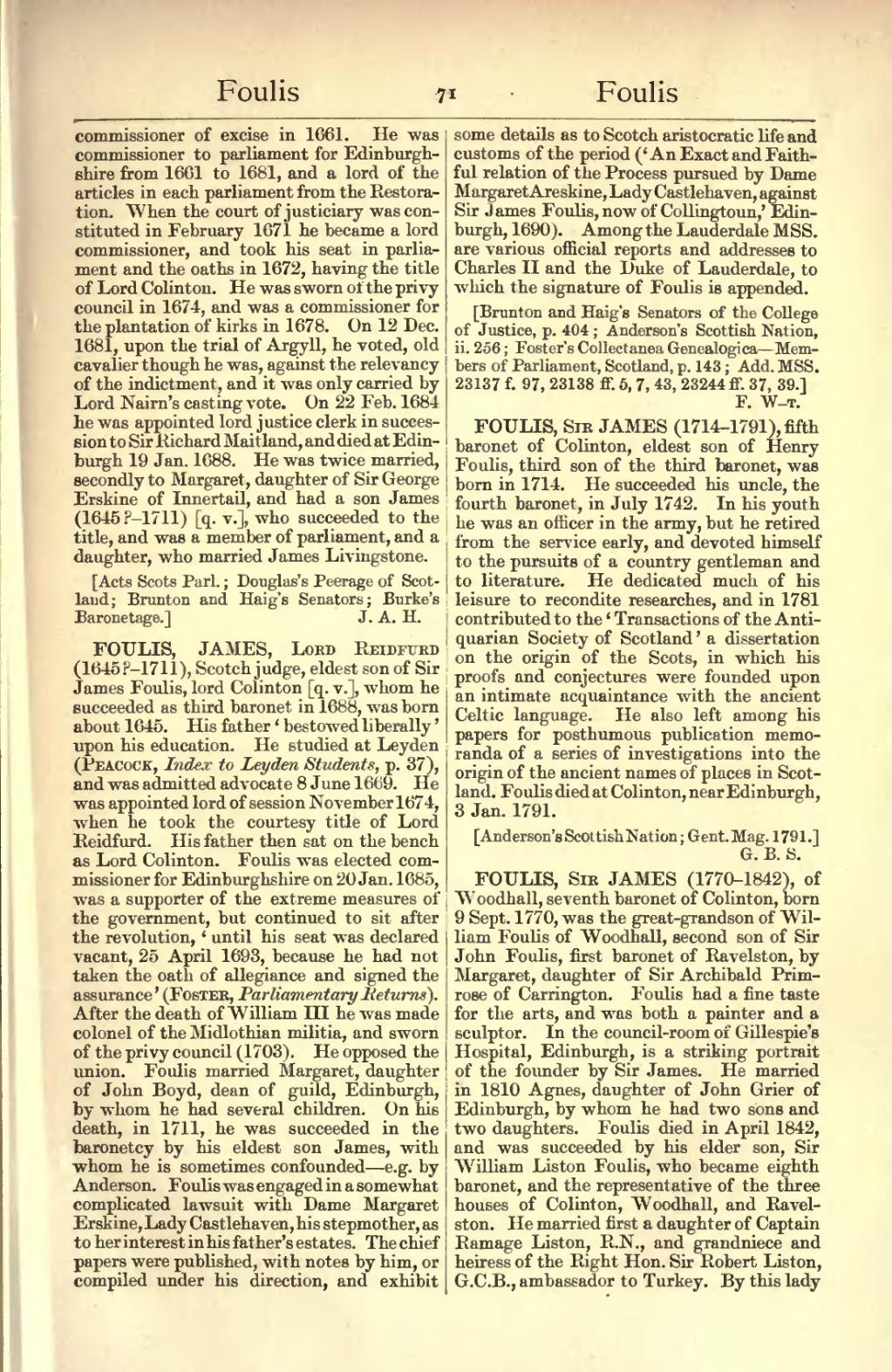commissioner of excise in 1661. He was commissioner to parliament for Edinburghshire from 1661 to 1681, and a lord of the articles in each parliament from the Restoration. When the court of justiciary was constituted in February 1671 he became a lord commissioner, and took his seat in parliament and the oaths in 1672, having the title of Lord Colinton. He was sworn of the privy council in 1674, and was a commissioner for the plantation of kirks in 1678. On 12 Dec. 1681, upon the trial of Argyll, he voted, old cavalier though he was, against the relevancy of the indictment, and it was only carried by Lord Nairn's casting vote. On 22 Feb. 1684 he was appointed lord justice clerk in succession to Sir Richard Maitland, and died at Edinburgh 19 Jan. 1688. He was twice married, secondly to Margaret, daughter of Sir George Erskine of Innertail, and had a son James (1645?–1711) [q. v.], who succeeded to the title, and was a member of parliament, and a daughter, who married James Livingstone.
[Acts Scots Parl.; Douglas's Peerage of Scotland; Brunton and Haig's Senators; Burke's Baronetage.]
FOULIS, JAMES, Lord Reidfurd (1645?–1711), Scotch judge, eldest son of Sir James Foulis, lord Colinton [q. v.], whom he succeeded as third baronet in 1688, was born about 1645. His father ' bestowed liberally ' upon his education. He studied at Leyden (Peacock, Index to Leyden Students, p. 37), and was admitted advocate 8 June 1669. He was appointed lord of session November 1674, when he took the courtesy title of Lord Reidfurd. His father then sat on the bench as Lord Colinton. Foulis was elected commissioner for Edinburghshire on 20 Jan. 1685, was a supporter of the extreme measures of the government, but continued to sit after the revolution, ' until his seat was declared vacant, 25 April 1693, because he had not taken the oath of allegiance and signed the assurance' (Foster, Parliamentary Returns). After the death of William III he was made colonel of the Midlothian militia, and sworn of the privy council (1703). He opposed the union. Foulis married Margaret, daughter of John Boyd, dean of guild, Edinburgh, by whom he had several children. On his death, in 1711, he was succeeded in the baronetcy by his eldest son James, with whom he is sometimes confounded—e.g. by Anderson. Foulis was engaged in a somewhat complicated lawsuit with Dame Margaret Erskine, Lady Castlehaven, his stepmother, as to her interest in his father's estates. The chief papers were published, with notes by him, or compiled under his direction, and exhibit some details as to Scotch aristocratic life and customs of the period ('An Exact and Faithful relation of the Process pursued by Dame Margaret Areskine, Lady Castlehaven, against Sir James Foulis, now of Collingtoun,' Edinburgh, 1690). Among the Lauderdale MSS. are various official reports and addresses to Charles II and the Duke of Lauderdale, to which the signature of Foulis is appended.
[Brunton and Haig's Senators of the College of Justice, p. 404; Anderson's Scottish Nation, ii. 256; Foster's Collectanea Genealogica—Members of Parliament, Scotland, p. 143 ; Add. MSS. 23137 f. 97, 23138 ff. 5, 7, 43, 23244 ff. 37, 39.]
FOULIS, Sir JAMES (1714–1791), fifth baronet of Colinton, eldest son of Henry Foulis, third son of the third baronet, was born in 1714. He succeeded his uncle, the fourth baronet, in July 1742. In his youth he was an officer in the army, but he retired from the service early, and devoted himself to the pursuits of a country gentleman and to literature. He dedicated much of his leisure to recondite researches, and in 1781 contributed to the 'Transactions of the Antiquarian Society of Scotland' a dissertation on the origin of the Scots, in which his proofs and conjectures were founded upon an intimate acquaintance with the ancient Celtic language. He also left among his papers for posthumous publication memoranda of a series of investigations into the origin of the ancient names of places in Scotland. Foulis died at Colinton, near Edinburgh, 3 Jan. 1791.
[Anderson's Scottish Nation; Gent. Mag. 1791.]
FOULIS, Sir JAMES (1770–1842), of Woodhall, seventh baronet of Colinton, born 9 Sept. 1770, was the great-grandson of William Foulis of Woodhall, second son of Sir John Foulis, first baronet of Ravelston, by Margaret, daughter of Sir Archibald Primrose of Carrington. Foulis had a fine taste for the arts, and was both a painter and a sculptor. In the council-room of Gillespie's Hospital, Edinburgh, is a striking portrait of the founder by Sir James. He married in 1810 Agnes, daughter of John Grier of Edinburgh, by whom he had two sons and two daughters. Foulis died in April 1842, and was succeeded by his elder son, Sir William Liston Foulis, who became eighth baronet, and the representative of the three houses of Colinton, Woodhall, and Ravelston. He married first a daughter of Captain Ramage Liston, R.N., and grandniece and heiress of the Right Hon. Sir Robert Liston, G.C.B., ambassador to Turkey. By this lady
